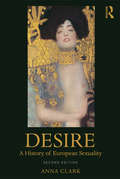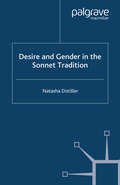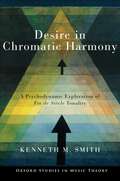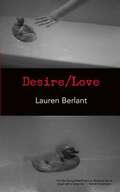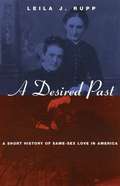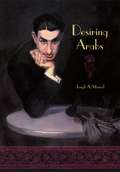- Table View
- List View
Desire: A History of European Sexuality
by Anna Clark‘… the rich range of historical information that Clark weaves into her chapters... makes this ambitious overview of sex in Europe a highly accessible and successful endeavour.’ – Times Higher Education Supplement 'Provides a valuable overview of the history of sexuality in Europe since classical antiquity, synthesising as it does a mass of studies of specific regions and periods which have appeared during the last two decades.' Lesley Hall, Wellcome Library, UK Desire: A History of European Sexuality is a sweeping survey of sexuality in Europe from the Greeks to the present day. It traces two concepts of sexual desire that have competed in European history: desire as dangerous, polluting, and disorderly; and desire as creative, transcendent, even revolutionary. This book follows these changing attitudes toward sexuality through the major turning points of European history. Written in a lively and engaging style, the book contains many fascinating anecdotes drawing on a rich array of sources including poetry, novels, pornography and film as well as court records, autobiographies and personal letters. While Anna Clark builds on the work of dozens of historians, she also takes a fresh approach and introduces the concepts of twilight moments and sexual economies. Desire integrates the history of heterosexuality with same-sex desire, and focuses on the emotions of love as well as the passions of lust, the politics of sex as well as the personal experiences.
Desire: A History of European Sexuality
by Anna Clark‘… the rich range of historical information that Clark weaves into her chapters... makes this ambitious overview of sex in Europe a highly accessible and successful endeavour.’ – Times Higher Education Supplement 'Provides a valuable overview of the history of sexuality in Europe since classical antiquity, synthesising as it does a mass of studies of specific regions and periods which have appeared during the last two decades.' Lesley Hall, Wellcome Library, UK Desire: A History of European Sexuality is a sweeping survey of sexuality in Europe from the Greeks to the present day. It traces two concepts of sexual desire that have competed in European history: desire as dangerous, polluting, and disorderly; and desire as creative, transcendent, even revolutionary. This book follows these changing attitudes toward sexuality through the major turning points of European history. Written in a lively and engaging style, the book contains many fascinating anecdotes drawing on a rich array of sources including poetry, novels, pornography and film as well as court records, autobiographies and personal letters. While Anna Clark builds on the work of dozens of historians, she also takes a fresh approach and introduces the concepts of twilight moments and sexual economies. Desire integrates the history of heterosexuality with same-sex desire, and focuses on the emotions of love as well as the passions of lust, the politics of sex as well as the personal experiences.
Desire: A History of European Sexuality
by Anna ClarkA sweeping survey of sexuality in Europe from the Greeks to the present, Desire: A History of European Sexuality follows changing attitudes to two major concepts of sexual desire – desire as dangerous, polluting, and disorderly, and desire as creative, transcendent, even revolutionary – through the major turning points of European history. Chronological in structure, and wide ranging in scope, Desire addresses such topics as sex in ancient Judaism, Christianity, and Islam, sexual contact and culture clash in Spain and colonial Mesoamerica, new attitudes toward sexuality in the seventeenth and eighteenth centuries, and sex in Bolshevik Russia and Nazi Germany. The book introduces the concept of "twilight moments" to describe activities seen as shameful or dishonorable, but which were tolerated when concealed by shadows, and integrates the history of heterosexuality with same-sex desire, as well as exploring the emotions of love and lust as well as the politics of sex and personal experiences. This new edition has been updated to include a new chapter on sex and imperialism and expanded discussions of Islam and trans issues. Drawing on a rich array of sources, including poetry, novels, pornography, and film, as well as court records, autobiographies, and personal letters, and written in a lively, engaging style, Desire remains an essential resource for scholars and students of the history of European sexuality, as well as women’s and gender history, social and cultural history and LGBTQ history.
Desire: A History of European Sexuality
by Anna ClarkA sweeping survey of sexuality in Europe from the Greeks to the present, Desire: A History of European Sexuality follows changing attitudes to two major concepts of sexual desire – desire as dangerous, polluting, and disorderly, and desire as creative, transcendent, even revolutionary – through the major turning points of European history. Chronological in structure, and wide ranging in scope, Desire addresses such topics as sex in ancient Judaism, Christianity, and Islam, sexual contact and culture clash in Spain and colonial Mesoamerica, new attitudes toward sexuality in the seventeenth and eighteenth centuries, and sex in Bolshevik Russia and Nazi Germany. The book introduces the concept of "twilight moments" to describe activities seen as shameful or dishonorable, but which were tolerated when concealed by shadows, and integrates the history of heterosexuality with same-sex desire, as well as exploring the emotions of love and lust as well as the politics of sex and personal experiences. This new edition has been updated to include a new chapter on sex and imperialism and expanded discussions of Islam and trans issues. Drawing on a rich array of sources, including poetry, novels, pornography, and film, as well as court records, autobiographies, and personal letters, and written in a lively, engaging style, Desire remains an essential resource for scholars and students of the history of European sexuality, as well as women’s and gender history, social and cultural history and LGBTQ history.
Desire: Women Write About Wanting
by Lisa Solod WarrenA captivating collection of essays, Desire delves headfirst into its subject matter and explores the complexity of desire with essays about the things women want, crave, lust after, and covet. An extraordinary group of writers tackle difficult and taboo subjects, from Debra Magpie Earling’s desire to hurt someone, to New York Times writer S. S. Fair’s less than diminishing sensual and sexual desire, despite her increasing age, to Julia Serano’s strong emotional impulse to be a woman before she decided to transition from male to female.Many of these essayists examine the feelings and experiences which surround the things they want but can’t-or shouldn’t-have. The reasons such desires are taboo are often personal and range from social conventions and religious teachings to more concrete laws and rules. Desire makes the private public and illuminates the rich and varied desires women have.
Desire and Consent in Representations of Adolescent Sexuality with Adults (Routledge Research in Cultural and Media Studies)
by Maureen Turim Diane WaldmanThis book presents an innovative comparative view of how the issue of adolescent sexuality and consent is differently treated in various media. Analyzing teenage sexual encounters with adults across a variety of media, including films, television, novels, and podcasts, the volume takes a positive stance on the expression of teenage sexuality, while remaining sensitive to the power of adults to abuse and manipulate. The anthology treats these representations as negotiations between conflicting forces: desire, sexual self-knowledge, unequal power, and the law, the latter both actual legal statutes and internalized law in the philosophical and psychoanalytic sense. Questions of unequal power inherent in such relations are theorized. The authors examine variations of this configuration of sexual relations between teenagers and adults from different perspectives, to consider how various forms of expression rework it formally. These essays are attuned to both nuances of presentation and contexts of reception, and they consider how aesthetics play a role. Contributing to the general debate about the ways that societies construct and regulate adolescent sexuality, this book will be of great interest to scholars and students of media studies, cultural studies, film studies, television studies, sociology, and gender studies
Desire and Consent in Representations of Adolescent Sexuality with Adults (Routledge Research in Cultural and Media Studies)
by Maureen Turim Diane WaldmanThis book presents an innovative comparative view of how the issue of adolescent sexuality and consent is differently treated in various media. Analyzing teenage sexual encounters with adults across a variety of media, including films, television, novels, and podcasts, the volume takes a positive stance on the expression of teenage sexuality, while remaining sensitive to the power of adults to abuse and manipulate. The anthology treats these representations as negotiations between conflicting forces: desire, sexual self-knowledge, unequal power, and the law, the latter both actual legal statutes and internalized law in the philosophical and psychoanalytic sense. Questions of unequal power inherent in such relations are theorized. The authors examine variations of this configuration of sexual relations between teenagers and adults from different perspectives, to consider how various forms of expression rework it formally. These essays are attuned to both nuances of presentation and contexts of reception, and they consider how aesthetics play a role. Contributing to the general debate about the ways that societies construct and regulate adolescent sexuality, this book will be of great interest to scholars and students of media studies, cultural studies, film studies, television studies, sociology, and gender studies
Desire and Empathy in Twentieth-Century Dystopian Fiction (Palgrave Studies In Utopianism Ser.)
by Thomas HoranThis book assesses key works of twentieth-century dystopian fiction, including Katharine Burdekin’s Swastika Night, George Orwell’s Nineteen Eighty-Four, and Margaret Atwood’s The Handmaid’s Tale, to demonstrate that the major authors of this genre locate empathy and morality in eroticism. Taken together, these books delineate a subset of politically conscious speculative literature, which can be understood collectively as projected political fiction. While Thomas Horan addresses problematic aspects of this subgenre, particularly sexist and racist stereotypes, he also highlights how some of these texts locate social responsibility in queer and other non-heteronormative sexual relationships. In these novels, even when the illicit relationship itself is truncated, sexual desire fosters hope and community.
Desire and Empathy in Twentieth-Century Dystopian Fiction
by Thomas HoranThis book assesses key works of twentieth-century dystopian fiction, including Katharine Burdekin’s Swastika Night, George Orwell’s Nineteen Eighty-Four, and Margaret Atwood’s The Handmaid’s Tale, to demonstrate that the major authors of this genre locate empathy and morality in eroticism. Taken together, these books delineate a subset of politically conscious speculative literature, which can be understood collectively as projected political fiction. While Thomas Horan addresses problematic aspects of this subgenre, particularly sexist and racist stereotypes, he also highlights how some of these texts locate social responsibility in queer and other non-heteronormative sexual relationships. In these novels, even when the illicit relationship itself is truncated, sexual desire fosters hope and community.
Desire and Gender in the Sonnet Tradition
by N. DistillerThis new study explores the poetic tradition of the love sonnet sequence in English as written by women from 1621-1931. It connects this tradition to ways of speaking desire in public in operation today, and to the development of theories of subjectivity in Western culture.
Desire Between Women in Caribbean Literature (New Caribbean Studies)
by K. ValensRelations between women - like the branches and roots of the mangrove - twist around, across, and within others as they pervade Caribbean letters. Desire between Women in Caribbean Literature elucidates the place of desire between women in Caribbean letters, compelling readers to rethink how to read the structures and practices of sexuality.
Desire in Chromatic Harmony: A Psychodynamic Exploration of Fin de Siècle Tonality (Oxford Studies in Music Theory)
by Kenneth M. SmithHow does musical harmony engage listeners in relations of desire? Where does this desire come from? Author Kenneth Smith seeks to answer these questions by analyzing works from the turn of the twentieth- century that are both harmonically enriched and psychologically complex. Desire in Chromatic Harmony yields a new theory of how chromatic chord progressions direct the listener on intricate journeys through harmonic space, mirroring the tensions of the psyche found in Schopenhauer, Freud, Lacan, Lyotard, and Deleuze. Smith extends this mode of enquiry into sophisticated music theory, while exploring philosophically engaged European and American composers such as Richard Strauss, Alexander Skryabin, Josef Suk, Charles Ives, and Aaron Copland. Focusing on harmony and chord progression, the book drills down into the diatonic undercurrent beneath densely chromatic and dissonant surfaces. From the obsession with death and mourning in Suk's asrael Symphony to an exploration of "perversion" in Strauss's elektra; from the Sufi mysticism of Szymanowski's Song of the Night to the failed fantasy of the American dream in Copland's The Tender Land, Desire in Chromatic Harmony cuts a path through the dense forests of chromatic complexity, revealing the psychological make-up of post-Wagnerian psychodynamic music.
Desire in Chromatic Harmony: A Psychodynamic Exploration of Fin de Siècle Tonality (Oxford Studies in Music Theory)
by Kenneth M. SmithHow does musical harmony engage listeners in relations of desire? Where does this desire come from? Author Kenneth Smith seeks to answer these questions by analyzing works from the turn of the twentieth- century that are both harmonically enriched and psychologically complex. Desire in Chromatic Harmony yields a new theory of how chromatic chord progressions direct the listener on intricate journeys through harmonic space, mirroring the tensions of the psyche found in Schopenhauer, Freud, Lacan, Lyotard, and Deleuze. Smith extends this mode of enquiry into sophisticated music theory, while exploring philosophically engaged European and American composers such as Richard Strauss, Alexander Skryabin, Josef Suk, Charles Ives, and Aaron Copland. Focusing on harmony and chord progression, the book drills down into the diatonic undercurrent beneath densely chromatic and dissonant surfaces. From the obsession with death and mourning in Suk's asrael Symphony to an exploration of "perversion" in Strauss's elektra; from the Sufi mysticism of Szymanowski's Song of the Night to the failed fantasy of the American dream in Copland's The Tender Land, Desire in Chromatic Harmony cuts a path through the dense forests of chromatic complexity, revealing the psychological make-up of post-Wagnerian psychodynamic music.
Desire in the Age of Robots and AI: An Investigation in Science Fiction and Fact
by Rebecca GibsonThis book examines how science fiction’s portrayal of humanity’s desire for robotic companions influences and reflects changes in our actual desires. It begins by taking the reader on a journey that outlines basic human desires—in short, we are storytellers, and we need the objects of our desire to be able to mirror that aspect of our beings. This not only explains the reasons we seek out differences in our mates, but also why we crave sex and romance with robots. In creating a new species of potential companions, science fiction highlights what we already want and how our desires dictate—and are in return recreated— by what is written. But sex with robots is more than a sci-fi pop-culture phenomenon; it’s a driving force in the latest technological advances in cybernetic science. As such, this book looks at both what we imagine and what we can create in terms of the newest iterations of robotic companionship.
Desire Lines: Space, Memory and Identity in the Post-Apartheid City (Architext)
by N. Murray N Shepherd M. HallThis ground breaking new work draws together a cross-section of South African scholars to provide a lively and comprehensive review of the under-researched area of heritage practice following the introduction of the National Heritage Resources Act. Looking at the daily heritage debates, from naming streets to projects such as the Gateway to Robben Island, Desire Lines addresses the innovative strategies that have emerged in the practice of defining, identifying and developing heritage sites. In a unique multi-disciplinary approach, contributions are featured from a broad spectrum of fields, including the built environment and public culture and education. Showcasing work from tour operators and museum curators alongside that of university-based scholars, this book is a comprehensive and singularly authoritative volume that charts the development of new and emergent public cultures in post-apartheid South Africa through the making and unmaking of its urban spaces. This pioneering collection of essays and case studies is an indispensable guide for those working within or studying heritage practice.
Desire Lines: Space, Memory and Identity in the Post-Apartheid City (Architext)
by Noëleen Murray Nick Shepherd Martin HallThis ground breaking new work draws together a cross-section of South African scholars to provide a lively and comprehensive review of the under-researched area of heritage practice following the introduction of the National Heritage Resources Act. Looking at the daily heritage debates, from naming streets to projects such as the Gateway to Robben Island, Desire Lines addresses the innovative strategies that have emerged in the practice of defining, identifying and developing heritage sites. In a unique multi-disciplinary approach, contributions are featured from a broad spectrum of fields, including the built environment and public culture and education. Showcasing work from tour operators and museum curators alongside that of university-based scholars, this book is a comprehensive and singularly authoritative volume that charts the development of new and emergent public cultures in post-apartheid South Africa through the making and unmaking of its urban spaces. This pioneering collection of essays and case studies is an indispensable guide for those working within or studying heritage practice.
Desire/Love
by Lauren Berlant“There is nothing more alienating than having your pleasures disputed by someone with a theory,” writes Lauren Berlant. Yet the ways in which we live sexuality and intimacy have been profoundly shaped by theories — especially psychoanalytic ones, which have helped to place sexuality and desire at the center of the modern story about what a person is and how her history should be read. At the same time, other modes of explanation have been offered by popular and mass culture. In these domains, sexual desire is not deemed the core story of life; it is mixed up with romance, a particular version of the story of love. In this small theoretical novella-cum-dictionary entry, Lauren Berlant engages love and desire in separate entries. In the first entry, Desire mainly describes the feeling one person has for something else: it is organized by psychoanalytic accounts of attachment, and tells briefly the history of their importance in critical theory and practice. The second entry, on Love, begins with an excursion into fantasy, moving away from the parent-child structure so central to psychoanalysis and looking instead at the centrality of context, environment, and history. The entry on Love describes some workings of romance across personal life and commodity culture, the place where subjects start to think about fantasy on behalf of their actual lives.
A Desired Past: A Short History of Same-Sex Love in America
by Leila J. RuppWith this book, Leila J. Rupp accomplishes what few scholars have even attempted: she combines a vast array of scholarship on supposedly discrete episodes in American history into an entertaining and entirely readable story of same-sex desire across the country and the centuries. "Most extraordinary about Leila J. Rupp's indeed short, two-hundred-page history of 'same-sex love and sexuality' is not that it manages to account for such a variety of individuals, races, and classes or take in such a broad chronological and thematic range, but rather that it does all this with such verve, lucidity, and analytical rigor. . . . [A]n elegant, inspiring survey." —John Howard, Journal of American History
A Desired Past: A Short History of Same-Sex Love in America
by Leila J. RuppWith this book, Leila J. Rupp accomplishes what few scholars have even attempted: she combines a vast array of scholarship on supposedly discrete episodes in American history into an entertaining and entirely readable story of same-sex desire across the country and the centuries. "Most extraordinary about Leila J. Rupp's indeed short, two-hundred-page history of 'same-sex love and sexuality' is not that it manages to account for such a variety of individuals, races, and classes or take in such a broad chronological and thematic range, but rather that it does all this with such verve, lucidity, and analytical rigor. . . . [A]n elegant, inspiring survey." —John Howard, Journal of American History
A Desired Past: A Short History of Same-Sex Love in America
by Leila J. RuppWith this book, Leila J. Rupp accomplishes what few scholars have even attempted: she combines a vast array of scholarship on supposedly discrete episodes in American history into an entertaining and entirely readable story of same-sex desire across the country and the centuries. "Most extraordinary about Leila J. Rupp's indeed short, two-hundred-page history of 'same-sex love and sexuality' is not that it manages to account for such a variety of individuals, races, and classes or take in such a broad chronological and thematic range, but rather that it does all this with such verve, lucidity, and analytical rigor. . . . [A]n elegant, inspiring survey." —John Howard, Journal of American History
A Desired Past: A Short History of Same-Sex Love in America
by Leila J. RuppWith this book, Leila J. Rupp accomplishes what few scholars have even attempted: she combines a vast array of scholarship on supposedly discrete episodes in American history into an entertaining and entirely readable story of same-sex desire across the country and the centuries. "Most extraordinary about Leila J. Rupp's indeed short, two-hundred-page history of 'same-sex love and sexuality' is not that it manages to account for such a variety of individuals, races, and classes or take in such a broad chronological and thematic range, but rather that it does all this with such verve, lucidity, and analytical rigor. . . . [A]n elegant, inspiring survey." —John Howard, Journal of American History
A Desired Past: A Short History of Same-Sex Love in America
by Leila J. RuppWith this book, Leila J. Rupp accomplishes what few scholars have even attempted: she combines a vast array of scholarship on supposedly discrete episodes in American history into an entertaining and entirely readable story of same-sex desire across the country and the centuries. "Most extraordinary about Leila J. Rupp's indeed short, two-hundred-page history of 'same-sex love and sexuality' is not that it manages to account for such a variety of individuals, races, and classes or take in such a broad chronological and thematic range, but rather that it does all this with such verve, lucidity, and analytical rigor. . . . [A]n elegant, inspiring survey." —John Howard, Journal of American History
A Desired Past: A Short History of Same-Sex Love in America
by Leila J. RuppWith this book, Leila J. Rupp accomplishes what few scholars have even attempted: she combines a vast array of scholarship on supposedly discrete episodes in American history into an entertaining and entirely readable story of same-sex desire across the country and the centuries. "Most extraordinary about Leila J. Rupp's indeed short, two-hundred-page history of 'same-sex love and sexuality' is not that it manages to account for such a variety of individuals, races, and classes or take in such a broad chronological and thematic range, but rather that it does all this with such verve, lucidity, and analytical rigor. . . . [A]n elegant, inspiring survey." —John Howard, Journal of American History
Desiring Arabs
by Joseph A. MassadSexual desire has long played a key role in Western judgments about the value of Arab civilization. In the past, Westerners viewed the Arab world as licentious, and Western intolerance of sex led them to brand Arabs as decadent; but as Western society became more sexually open, the supposedly prudish Arabs soon became viewed as backward. Rather than focusing exclusively on how these views developed in the West, in Desiring Arabs Joseph A. Massad reveals the history of how Arabs represented their own sexual desires. To this aim, he assembles a massive and diverse compendium of Arabic writing from the nineteenth century to the present in order to chart the changes in Arab sexual attitudes and their links to Arab notions of cultural heritage and civilization. A work of impressive scope and erudition, Massad’s chronicle of both the history and modern permutations of the debate over representations of sexual desires and practices in the Arab world is a crucial addition to our understanding of a frequently oversimplified and vilified culture. “A pioneering work on a very timely yet frustratingly neglected topic. . . . I know of no other study that can even begin to compare with the detail and scope of [this] work.”—Khaled El-Rouayheb, Middle East Report “In Desiring Arabs, [Edward] Said’s disciple Joseph A. Massad corroborates his mentor’s thesis that orientalist writing was racist and dehumanizing. . . . [Massad] brilliantly goes on to trace the legacy of this racist, internalized, orientalist discourse up to the present.”—Financial Times
Desiring Arabs
by Joseph A. MassadSexual desire has long played a key role in Western judgments about the value of Arab civilization. In the past, Westerners viewed the Arab world as licentious, and Western intolerance of sex led them to brand Arabs as decadent; but as Western society became more sexually open, the supposedly prudish Arabs soon became viewed as backward. Rather than focusing exclusively on how these views developed in the West, in Desiring Arabs Joseph A. Massad reveals the history of how Arabs represented their own sexual desires. To this aim, he assembles a massive and diverse compendium of Arabic writing from the nineteenth century to the present in order to chart the changes in Arab sexual attitudes and their links to Arab notions of cultural heritage and civilization. A work of impressive scope and erudition, Massad’s chronicle of both the history and modern permutations of the debate over representations of sexual desires and practices in the Arab world is a crucial addition to our understanding of a frequently oversimplified and vilified culture. “A pioneering work on a very timely yet frustratingly neglected topic. . . . I know of no other study that can even begin to compare with the detail and scope of [this] work.”—Khaled El-Rouayheb, Middle East Report “In Desiring Arabs, [Edward] Said’s disciple Joseph A. Massad corroborates his mentor’s thesis that orientalist writing was racist and dehumanizing. . . . [Massad] brilliantly goes on to trace the legacy of this racist, internalized, orientalist discourse up to the present.”—Financial Times

